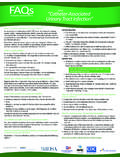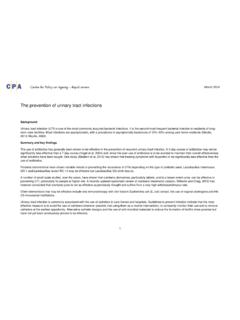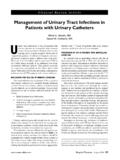Transcription of Prevention of catheter-associated urinary tract infection ...
1 Rev. Latino-Am. Enfermagem2016;24:e2678 DOI: ArticleAndrade VLF, Fernandes FAV. Prevention of catheter - associated urinary tract infection : implementation strategies of international guidelines. Rev. Latino-Am. Enfermagem. 2016;24:e2678. [Access ___ __ ____]; Available in: _____. DOI: of catheter - associated urinary tract infection : implementation strategies of international guidelines1 Vera L cia Fonseca Andrade2 Filipa Alexandra Veludo Fernandes3 Objective: to describe strategies used by health professionals on the implementation of the Centers for Disease Control and Prevention guidelines for the Prevention of urinary infection related to catheterism. Method: systematic review on literature based on data from CINAHL , Nursing & Allied Health Collection, Cochrane Plus Collection, MedicLatina, MEDLINE , Academic Search Complete, ACS - American Chemical Society, Health Reference Center Academic, Nursing Reference Center, ScienceDirect Journals and Wiley Online Library.
2 A sample of 13 articles was selected. Results: studies have highlighted the decrease of urinary tract infection related to catheterism through reminder systems to decrease of people submitted to urinary catheterism, audits about nursing professionals practice and bundles expansion. Conclusion: the present review systemizes the knowledge of used strategies by health professionals on introduction to international recommendations, describing a rate decrease of such infection in clinical : urinary tract Infections; urinary Catheterization; Paper extracted from master thesis Preven o da infec o associada a cuidados de sa de: um olhar sobre o papel da enfermagem , presented to Instituto de Ciencias da Sa de, Universidade Cat lica Portuguesa, Lisboa, MSc, Assistant Professor, Escola Superior Polit cnica de Sa de, Instituto de Ci ncias da Sa de, Universidade Cat lica Portuguesa, Lisboa, MSc, RN, Unidade de Cuidados Intensivos, Centro Hospitalar Barreiro Montijo, EPE, Barreiro, Latino-Am.
3 Enfermagem 2016;24:e2678 IntroductionCatheter- associated urinary tract infection (CAUTI) is frequent on hospitalized people. On infections associated to health care, catheter - associated urinary tract infection corresponds to 40%(1). About 15% to 25% of hospitalized people are submitted to vesical catheterization(2). In most cases, this technique is used without proper indication, extending its unnecessary use. CAUTI is referred to in several studies about increase on mortality and morbidity, as well as hospitalization, and, consequently, associated costs(2).However, it is pointed out that when compared to other healthcare- associated infections (HAI), urinary tract infection (UTI) presents a low morbidity. A study carried out in the USA(2) determined that UTI rate was superior to 560 thousands when compared to other HAIs, with a mortality rate of , and bacteriuria (which develop bactareamia) cases lower than 5%.
4 UTI is the main cause of infecctions on secondary nosocomial bloodstream, about 17% of nosocomial bactareamia origin from urinary , with an associated mortality of 10%. Society for Healthcare Epidemology of America (SHEA) estimates between 17% and 69% of CAUTI can be prevented through infection control recommendations, based on evidences(2).The investigation suggests that CAUTI Prevention goes through recommended actions, and based on evidences that lower the rate for this infection . Simple initiatives as hand hygiene, use of a reliable technique, maintenance and the way the catheter is removed can contribute to prevent the associated infection . An unnecessary urinary catheterism and the period of permanency of catheter influence the infection development, being modifiable factors(2).
5 Currently, the practice based on evidences is a highlight in a culture that aims a quality standard for safe care. However, it is pointed out that many times professionals face a few embarrassments regarding the connection between results from the most current and practical investigation. The way actions and/or strategies are applied for implementations, in one document, providing practical changeable tools to readers, based in measurable results. This systematic review supplies the answer to this need, gathering the scattered knowledge on literature and facilitating the access to safe practices based on evidences. The study s goal was to search evidences regarding strategies that health professionals found out on practice to apply/implement of CDC recommendations and CAUTI Prevention .
6 MethodThe structure of this systematic review on literature was based on the CAUTI thematic, elaborating the initial question, defining eligibility criteria, selecting article samples and further analysis and results discussion. To obtain the answer to the initial question What are the strategies health professionals use for implementing the Centers for Disease Control and Prevention (CDC) guidelines for CAUTI Prevention ? . A systematic review of the literature was made to reach this goal. As a research strategy, the following health descriptors were used: urinary AND infection AND catheter AND nurs*. To find answers to this question, the goal was to perceive how nurses operationalized the recommendations of the Centers for Disease Control and Prevention on praxis and intervention on CAUTI temporal limit of research was from January 2007 to December 2014, for fully available papers, as a way to contextualize the thematic in the past seven years.
7 The databases used were CINAHL , Nursing & Allied Health Collection, Cochrane Plus Collection, MedicLatina, MEDLINE , Academic Search Complete, ACS - American Chemical Society, Health Reference Center Academic, Nursing Reference Center, ScienceDirect Journals, and Wiley Online Library. Face to the studied phenomenon, the eligibility criteria were established according to Figure CriteriaInclusion CriteriaExclusion CriteriaParticipantsHospitalized people submitted to vesical catheterizationPeople submitted to chronic vesical catheterizationInterventionStrategies for the implementation of the Centers for Disease Control and Prevention guidelines for urinary tract infections associated to catheterismGuidelines review; usage of materials on control and Prevention of catheterization- associated urinary tract infections.
8 Administration of antibiotherapy on Prevention of urinary tract infectionResultsNumber of vesical catheterization, duration of vesical catheterization, urinary tract infection rate associated to catheterism Guidelines implementation without evaluation of its impact (the Figure 1 continue in the next ) VLF, Fernandes CriteriaInclusion CriteriaExclusion CriteriaDrawPrimary studies with quantitative approachOpinion studies, primary studies with qualitative 1 Inclusion and exclusion criteriaAfterwards, the articles were classified in accordance to evidence level (4), determining that most of the selected articles presented a high level of evidence, considering about 70% are on evidence level Ib. On evidence level Ib, the scientific evidence comes from, at least, a random clinical trial.
9 Following two articles placed on evidence level IIa, and two articles on level Ia, the last one being the higher evidence level(4). On level IIa, the evidence was obtained through a forward study controlled and well designed, without randomization. On level Ia, the scientific evidence obtains through a met-analysis of random clinical trials. The 13 selected articles, according the evidence level, are presented on Figure would like to highlight that the exclusion of articles was also related to lack of information about parameters considered important for the analysis; participants, interventions, results, study s draw. Facing the studies diversity and non-relevance to the investigation question, the parameter Comparison [C] was removed.
10 We also considered, when selecting the studies, the bibliographic references mentioned(3). On the initial phase, 92 articles were obtained, from which, 38 were excluded by their titles. After reading 53 abstracts, 29 articles were rejected. Twenty-five articles were fully analyzed, from which 12 were rejected, according the inclusion/exclusion criteria, leading to 13 articles selected to perform the systematic review on literature. Figure 2 is a flowchart of the mentioned article selection. Figure 2 Flowchart of articles selection Studies identified on databases (n = 92)Selected studies(n = 92)Duplicate studies removed(n = 0)Studies identified on other sources (n = 0)Excluded studies (n = 38)Full articles evaluated to eligibility (n = 25)Full articles excluded (n = 12)Studies included with qualitative approach (n = 0)Studies included with quantitative approach (n = 13) Latino-Am.

















